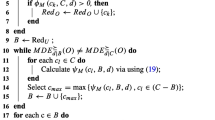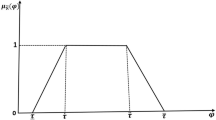Abstract
We consider decision tables with the values of conditional attributes (conditions) measured by sensors. These sensors produce outputs after an unknown but finite number of time units. We construct an algorithm for computing a highly parallel program represented by a Petri net from a given decision table. The constructed net allows to identify objects in decision tables to an extent which makes appropriate decisions possible. The outputs from sensors are propagated through the net with maximal speed. This is done by an appropriate implementation of all rules true in a given decision table. Our approach is based on rough set theory (Pawlak, 1991). It also seems to have some significance for theoretical foundations of real-time systems.
Similar content being viewed by others
References
Bazan, J., Skowron, A., and Synak, P. (1994a). Dynamic Reducts as a Tool for Extracting Laws From Decision Tables. In Proc of the Symp. on Methodologies for Intelligent Systems, Charlotte, NC, Lecture Notes in Artificial Intelligence, 869, 346–355, Berlin: Springer-Verlag.
Bazan, J., Son, N.H., Trung, N.T., Skowron, A., and Stepaniuk, J. (1994b). Some Logic and Rough Set Applications for Classifying Objects. Institute of Computer Science Report 38/94, Poland: Warsaw University of Technology.
Brown, E.M. (1990). Boolean Reasoning, Dordrecht: Kluwer Academic Publishers.
Brownston, L., Farrell, R., Kant, E., and Martin, N. (1986). Programming Expert Systems in OPS5. An Introduction to Rule-Based Programming, Reading, MA: Addison-Wesley.
Chaib-Draa, B., Moulin, B., Mandian, R., and Millot, P. (1992). Trends in Distributed Artificial Intelligence. Artificial Intelligence Review, 6(1), 35–66.
Chandrasekaran, B., Bhatnagar, R., and Sharma, D.D. (1991). Real-Time Disturbance Control. Comm. ACM, 34(8), 32–47.
Crowley, J.L. (1985). Navigation for an Intelligent Mobile Robot. IEEE Journal of Rob. Auto., RA-1, 31–41.
Edwards, K. (1993). Real-Time Structured Methods. Systems Analysis, New York: John Wiley and Sons.
Forgy, C.L. (1982). Rete: A Fast Algorithm for the Many Pattern/Many Object Pattern Match Problem. Artificial Intelligence, 19(1), 17–37.
Hack, M. (1975). Decidability Questions for Petri Nets. Ph.D Thesis, Department of Electrical Engineering, Massachusetts Institute of Technology, Cambridge.
Haves-Roth, B. (1990). Architectural Foundations for Real-Time Performance in Intelligent Agents. Journal of Real-Time Systems, 2, 99–125.
HRL (1994). Marked data, Hughes Research Laboratories, Personal Communication.
IEEE Transactions on Software Engineering, Special Issue: Specification and Analysis of Real-Time Systems, 18(9), September 1992.
Kodratoff, Y., Michalski, R. (Eds.) (1990). Machine Learning, Vol. 3, San Mateo, CA: Morgan Kaufmann Publishers.
Lesser, V.R., Pavlin, J., and Durfee, E. (1988). Approximate Processing in Real-Time Problem Solving. Artificial Intelligence Magazine.
Looney, C.G. (1988). Fuzzy Petri Nets for Rule-Based Decision-making. IEEE Trans. Syst., Man, Cybern., 18(1), 178–183.
Michalski, R., Carbonell, J.G., and Mitchell, T.M. (Eds.) (1983). Machine Learning: An Artificial Intelligence Approach, Vol. 1, Los Altos, CA: Tioga/Morgan Publishers.
Michalski, R. and Wn ek, J. (1993). Constructive Induction: An Automated Improvement of Knowledge Representation Spaces for Machine Learning. In Proc. of a Workshop on Intelligent Information Systems, Practical Aspects of AI II (pp. 188–236). Augustów, Poland.
Nadler, M. and Smith, E.P. (1993). Pattern Recognition Engineering, New York: John Wiley and Sons.
Paulos, D. and Wand, Y. (1992). An Automated Approach to Information Systems Decomposition. IEEE Trans. Software Eng., 18(3), 174–189.
Pawlak, Z. (1991). Rough Sets-Theoretical Aspects of Reasoning about Data, Dordrecht: Kluwer Academic Publishers.
Pawlak, Z. (1992). Concurrent Versus Sequential the Rough Sets Perspective. Bull. EATCS, 48, 178–190.
Pawlak, Z. and Skowron, A. (1993). A Rough Set Approach for Decision Rules Generation. In Proc. of the IJCAI'93 Workshop: The Management of Uncertainty in AI, France.
Payton, D.W. and Bihari, T.E. (1991). Intelligent Real-Time Control of Robotic Vehicles. Comm. ACM, 34(8), 48–63.
Peterson, J.L. (1981). Petri Net Theory and the Modeling of Systems, Englewood Cliffs, N.J.: Prentice-Hall, Inc.
Schoppers, M. (1991). Real-Time Knowledge-Based Control Systems. Comm. ACM, 34(8), 26–30.
Shavlik, J.W. and Dietterich, T.G. (Eds.)(1990). Readings in Machine Learning, San Mateo, CA: Morgan Kaufmann.
Shrager, J. and Langley, P. (1990). Computational models of scientific discovery and theory formation, San Mateo, CA: Morgan Kaufmann.
Skowron, A. (1993). A Synthesis of Decision Rules: Applications of Discernibility Matrices. In Proc. of a Workshop on Intelligent Information Systems, Practical Aspects of AI II (pp. 30–46). Augustów, Poland.
Skowron, A. and Rauszer, C. (1992). The Discernibility Matrices and Functions in Information Systems. R.Slowiński (Ed.), Intelligent Decision Support. Handbook of Applications and Advances of the Rough Sets Theory (pp. 331–362). Dordrecht: Kluwer Academic Publishers.
Skowron, A. and Stepaniuk, J. (1994). Decision rules based on discernibility matrices and decision matrices. In Proc. of The Third International Workshop on Rough Sets and Soft Computing (pp. 602–609). San Jose, CA.
Skowron, A. and Suraj, Z. (1993a). Synthesis of Concurrent Systems Specified by Information Systems. Institute of Computer Science Report 4/93, Warsaw University of Technology, Poland.
Skowron, A. and Suraj, Z. (1993b). A Rough Set Approach to Real-Time State Identification. Bull. EATCS, 50, 264–275.
Slowiñski, R. (Ed.) (1992). Intelligent Decision Support: Handbook of Applications and Advances of Rough Sets Theory, Dordrecht: Kluwer Academic Publishers.
Suraj, Z. (1995). PN-Tools: Environment for the Design and Analysis of Petri Nets. Control and Cybernetics, Systems Research Institute of Polish Academy of Sciences, 24(2), 199–222.
Wegener, I. (1987). The Complexity of Boolean Functions, Stuttgart, West Germany: John Wiley and Sons Ltd. and B.G. Teubner.
Author information
Authors and Affiliations
Rights and permissions
About this article
Cite this article
Skowron, A., Suraj, Z. A parallel algorithm for real-time decision making: A rough set approach. J Intell Inf Syst 7, 5–28 (1996). https://doi.org/10.1007/BF00125520
Issue Date:
DOI: https://doi.org/10.1007/BF00125520




